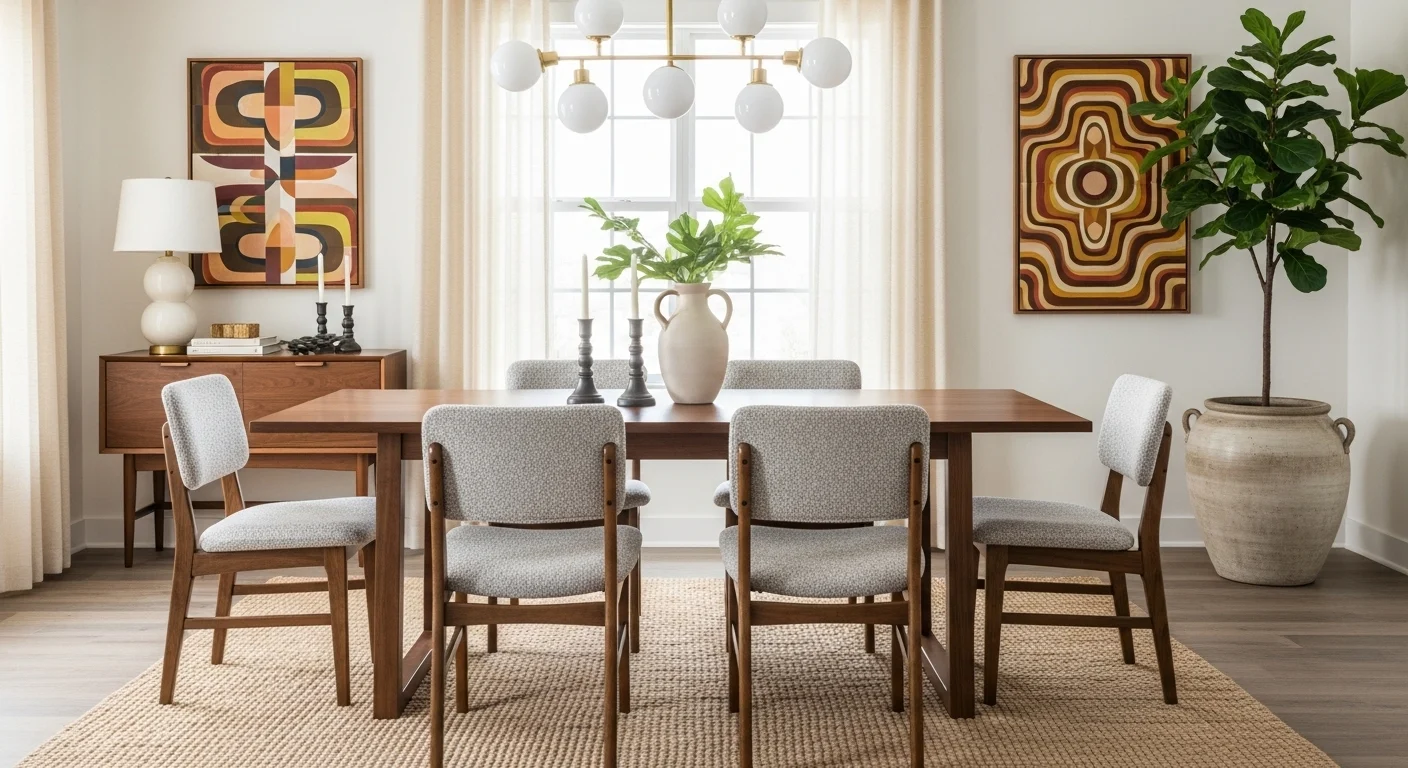So you love that sleek mid-century modern vibe but every time you try to recreate it, your dining room ends up looking like a Mad Men set rather than a space where people actually want to eat dinner. You’ve probably seen those rooms that scream “mid-century” so loud they feel more like a museum exhibit than a place where families gather.
Real mid-century dining room style isn’t about cramming every iconic piece from the era into one space. It’s about understanding the core principles—clean lines, organic materials, functional beauty—and applying them in ways that feel fresh and livable today. The best mid-century inspired rooms capture the optimism and sophistication of the era while still working for modern life.
Whether you’re working with genuine vintage pieces or contemporary furniture inspired by the period, these steps will help you create a mid-century dining room that feels authentic and sophisticated rather than costume-y. Ready to nail that effortless retro-luxury vibe?
Understanding Real Mid-Century Style
Before diving into the specifics, let’s talk about what mid-century dining room style actually is. It’s not just “throw some tapered legs on everything and add a starburst clock.”
Form Follows Function – Mid-century design prioritized pieces that were both beautiful and practical. Every element should serve a purpose while contributing to the overall aesthetic.
Natural Materials Done Right – The era celebrated wood grains, particularly walnut and teak, along with other organic materials like leather and stone. These materials should feel warm and inviting, not cold and sterile.
Clean Lines with Organic Touches – The geometric meets the organic. Sharp, angular furniture softened by curved elements and natural textures creates that perfect mid-century balance.
Build Your Foundation
Getting the major pieces right sets the stage for everything else to fall into place naturally.
Sculptural Dining Table
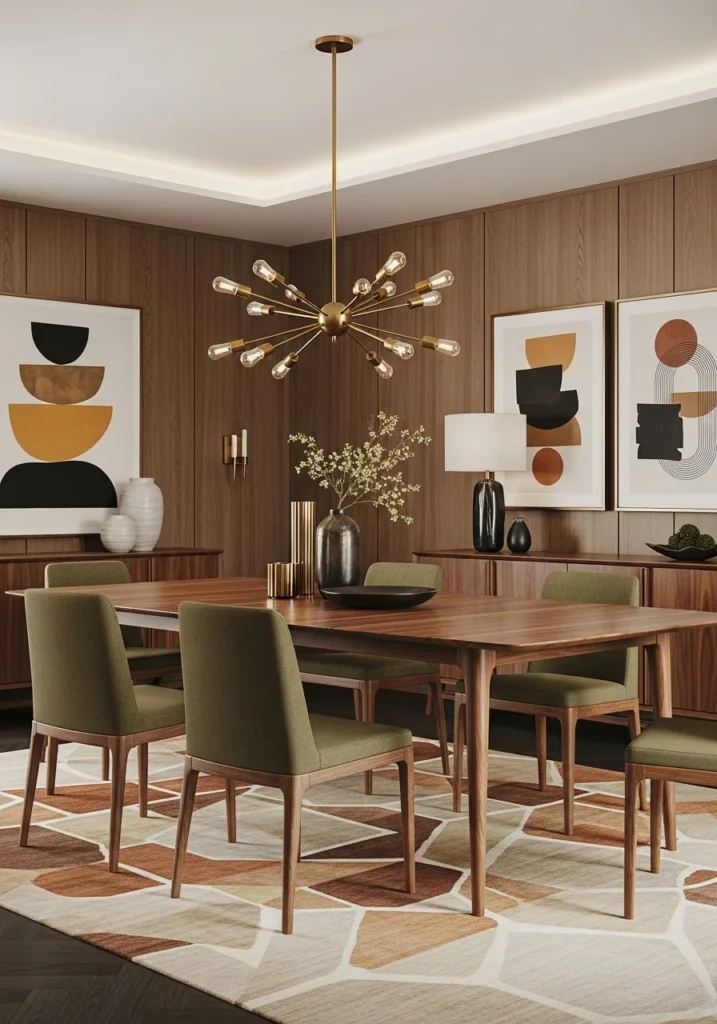
Your dining table needs to be the undisputed star. Go for a sculptural walnut piece with tapered legs and polished wood finish that showcases those gorgeous grain patterns. Pair with sleek upholstered chairs in muted olive fabric and place everything on a geometric rug in warm earthy tones.
A statement brass chandelier hanging above should echo those classic starburst forms while subtle wood paneling on walls provides the perfect backdrop for modern art in abstract shapes. The table anchors everything while letting other elements shine.
Create Drama With Statement Lighting
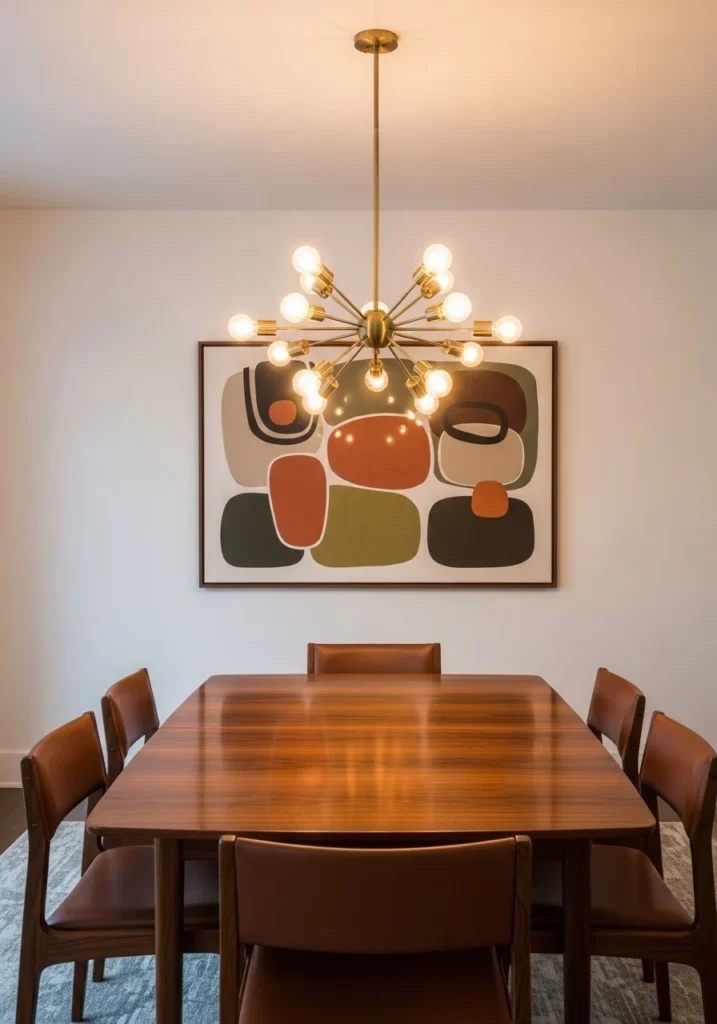
A dramatic Sputnik chandelier in brushed brass becomes the room’s jewelry, creating glow that reflects beautifully over a rectangular dining table in dark teak wood. Low-backed leather dining chairs complement the warm aesthetic while minimalist white walls and large abstract paintings create perfect balance.
The lighting should feel both modern and retro-luxury, casting flattering light that makes the wood grains glow and creates intimate dining atmosphere. This is where you can really embrace that iconic mid-century drama.
Embrace Walnut Wood Tones Throughout
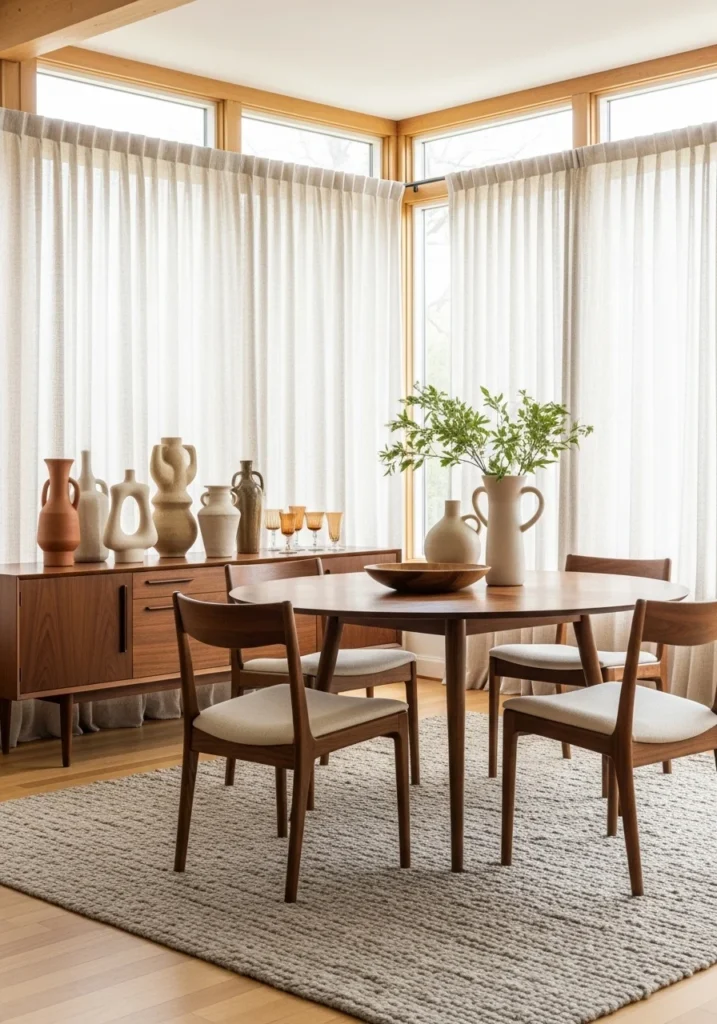
Layer walnut throughout your space—round dining table, tapered-leg sideboard, and walnut-framed chairs with cream upholstery create cohesive warmth. A shag rug in muted beige grounds the design while sculptural ceramics and vintage glassware on the sideboard add curated sophistication.
Large windows dressed in sheer linen drapes fill the space with natural light that highlights all those beautiful wood tones. The key is using walnut as a unifying element rather than your only material choice.
Ground the Space With Geometric Rugs
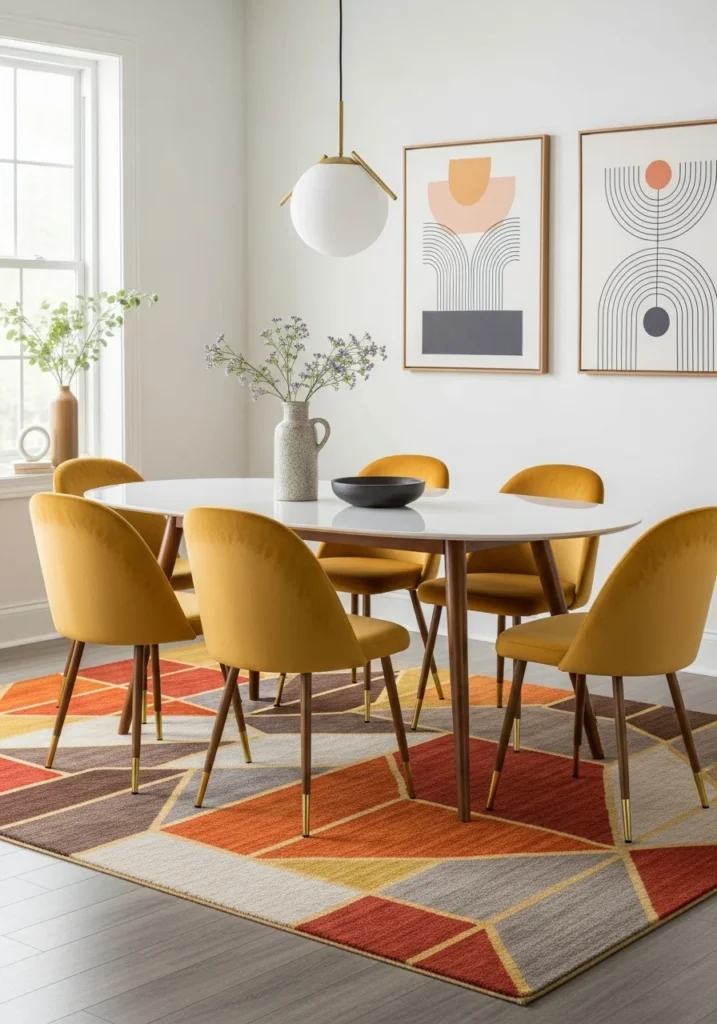
A bold geometric rug in burnt orange, taupe, and gold sets the stage for authentic mid-century style. Center an oval-shaped table with sleek wooden legs and surround with velvet dining chairs in mustard yellow for that perfect period color palette.
A globe pendant light softly illuminates while clean, abstract wall art ties the aesthetic together seamlessly. The rug should feel substantial enough to anchor your furniture while adding those signature mid-century patterns and colors.
Add Character Through Art and Accessories
Style With Retro-Inspired Art
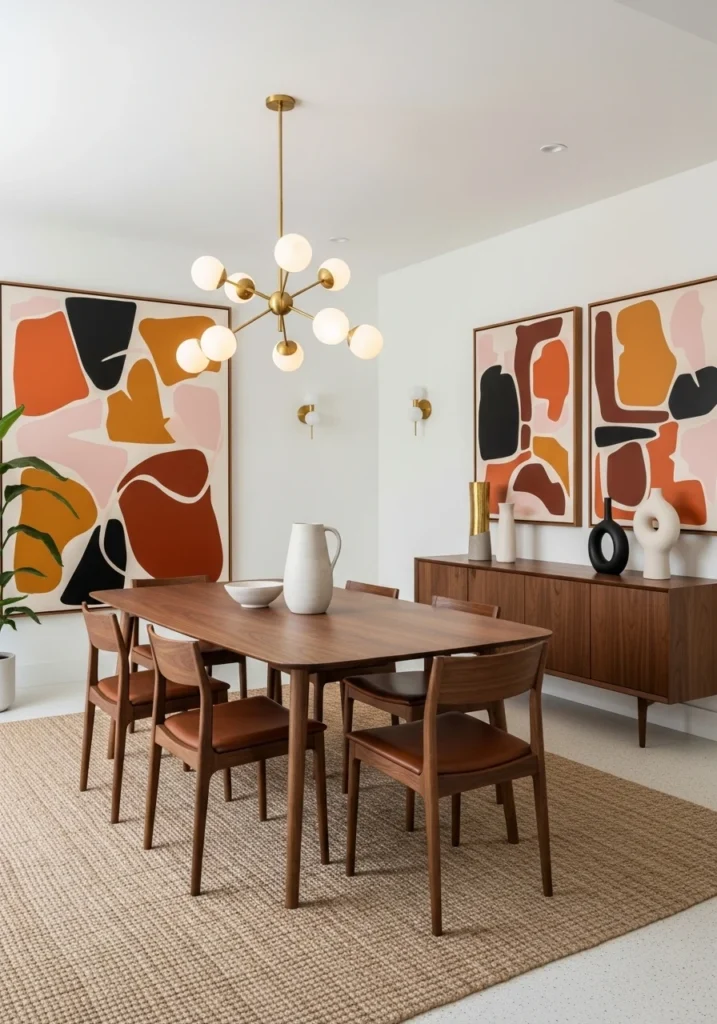
Oversized retro abstract art pieces in earthy oranges, browns, and creams create the perfect gallery wall moment. Position above a rectangular dining table with rounded corners, paired with minimalist dining chairs in rich leather.
Brass accents on lighting fixtures add refined touches while a floating credenza with sculptural decor completes the curated look. The art should feel substantial and confident, not like an afterthought.
Create Function With a Statement Sideboard
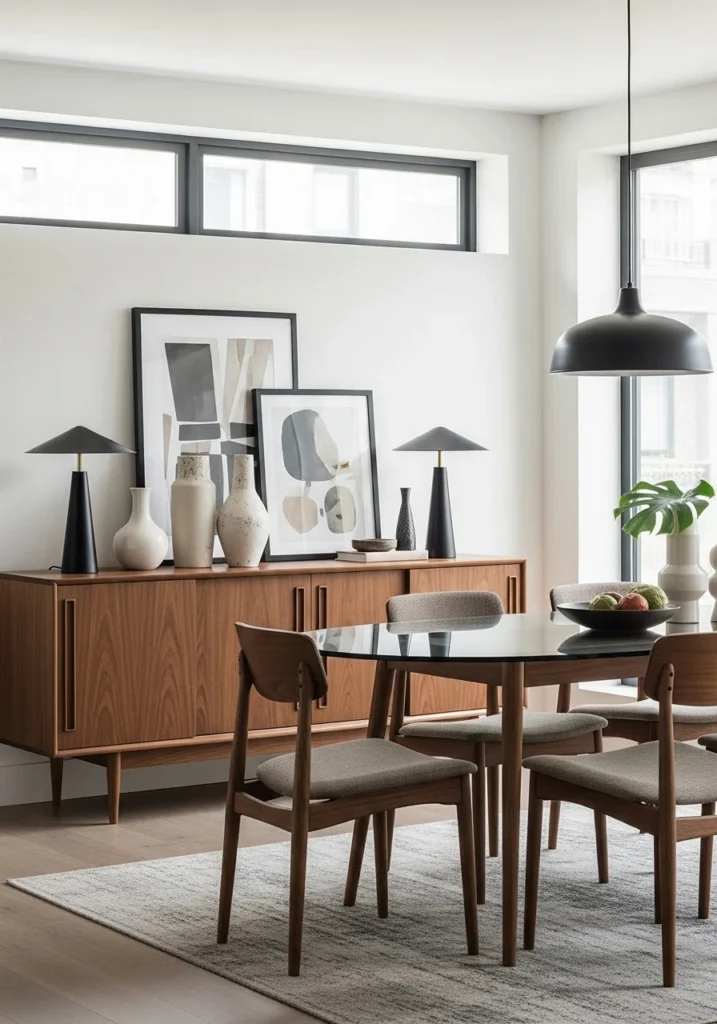
A walnut sideboard with sliding doors and brass handles becomes both storage and styling opportunity. Top with ceramic vases, framed prints, and sculptural lamps while your oval, glass-topped dining table surrounded by upholstered chairs with slender wooden legs creates the seating area.
A pendant in matte black contrasts beautifully with warm wooden tones throughout the space. The sideboard should feel like furniture that could work in any room, not just dining-specific pieces.
Soften With Organic Shapes
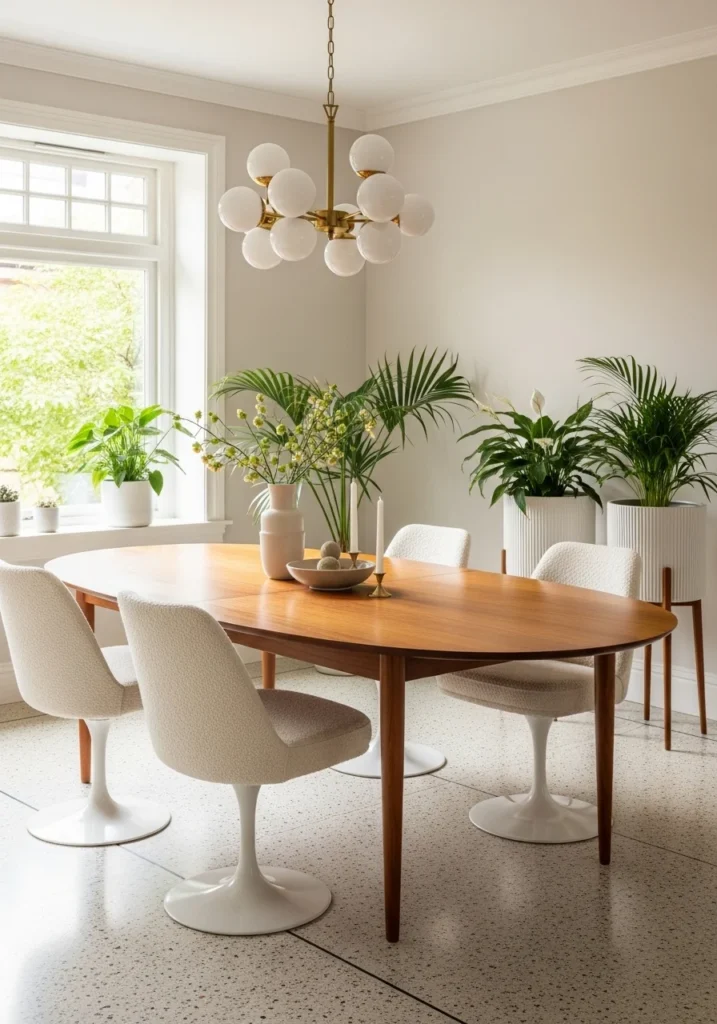
An oval teak dining table with softly rounded edges paired with tulip-style chairs upholstered in cream boucle brings in those organic forms that balance the geometric elements. A globe chandelier echoes the soft curves while terrazzo-style flooring grounds everything.
Potted plants in mid-century ceramic planters add living elements that soften the space and connect to the era’s love of bringing nature indoors. The curves should feel intentional, not arbitrary.
Also Read: 14 Dorm Room Designs That Blend Function, Style, and Serenity
Layer in the Signature Details
Add Warmth With Brass Accents
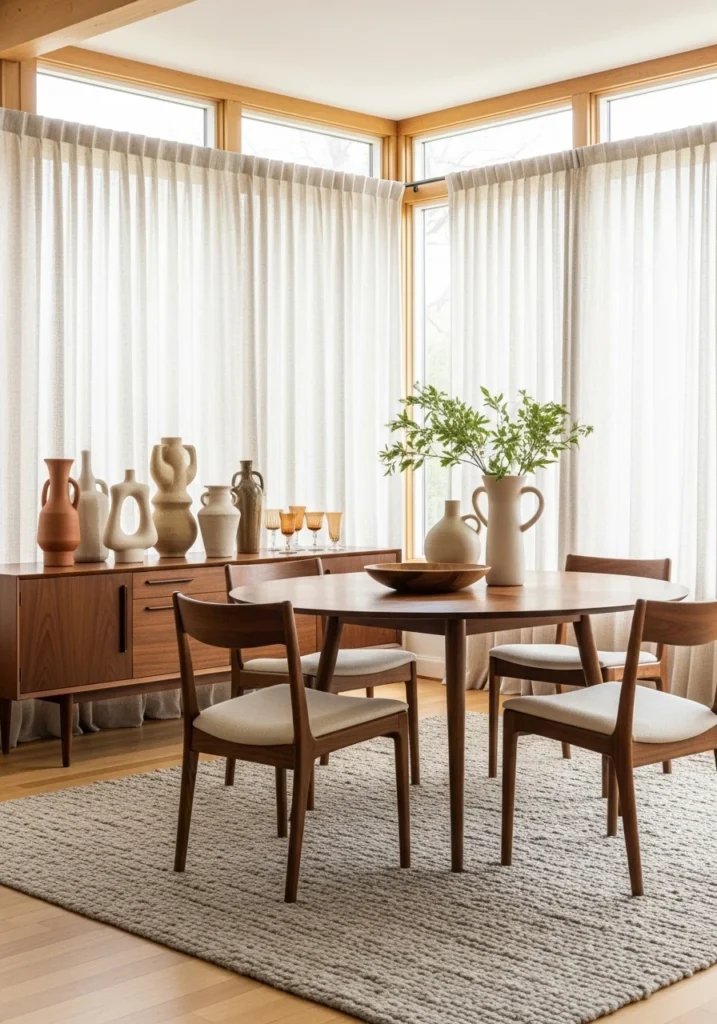
Let brass accents shine throughout—brass-legged chairs, sculptural brass pendants, and brass inlays on the sideboard create consistent metallic warmth. A rectangular walnut dining table with polished surface reflects subtle golden tones beautifully.
Keep walls neutral to let furniture take center stage while sculptural vases and framed retro prints add finishing touches. Brass should feel like jewelry for your room, not overwhelming decoration.
Have Fun With Color Pop Seating
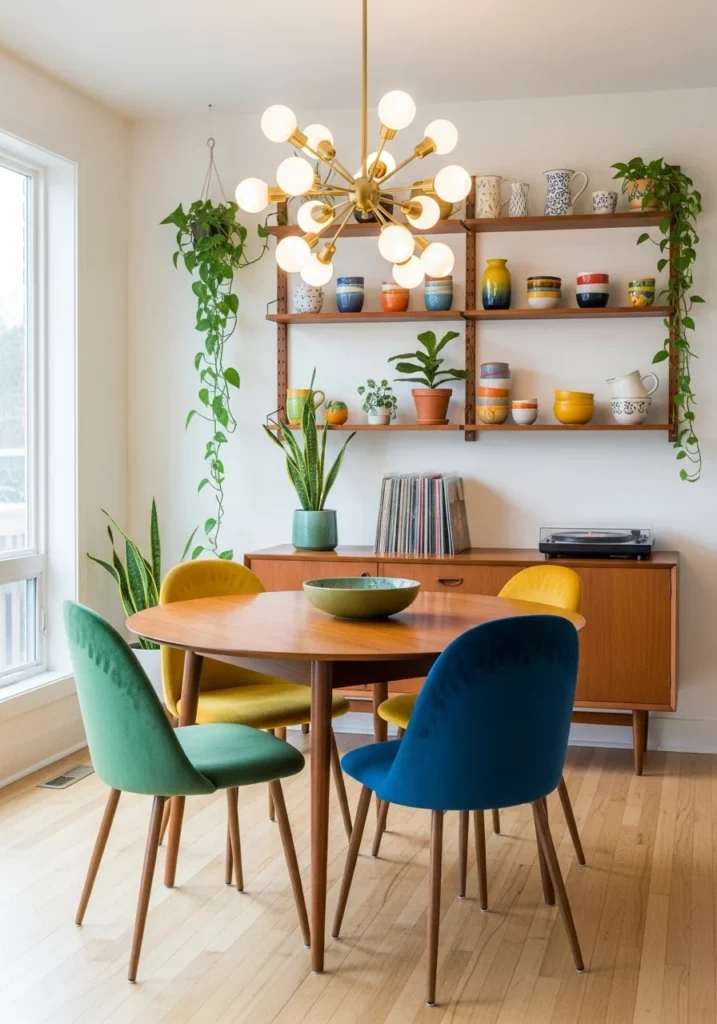
A round teak table surrounded by mismatched dining chairs in bold jewel tones—emerald, mustard, and deep blue velvet—creates playful sophistication. A starburst chandelier hangs above for drama while clean-lined shelving displays ceramics and plants.
The mismatched seating should feel intentional and curated rather than random. Each chair should relate to the others through scale, material, or form even if the colors are different.
Perfect the Architectural Details
Create Depth With Wall Treatments
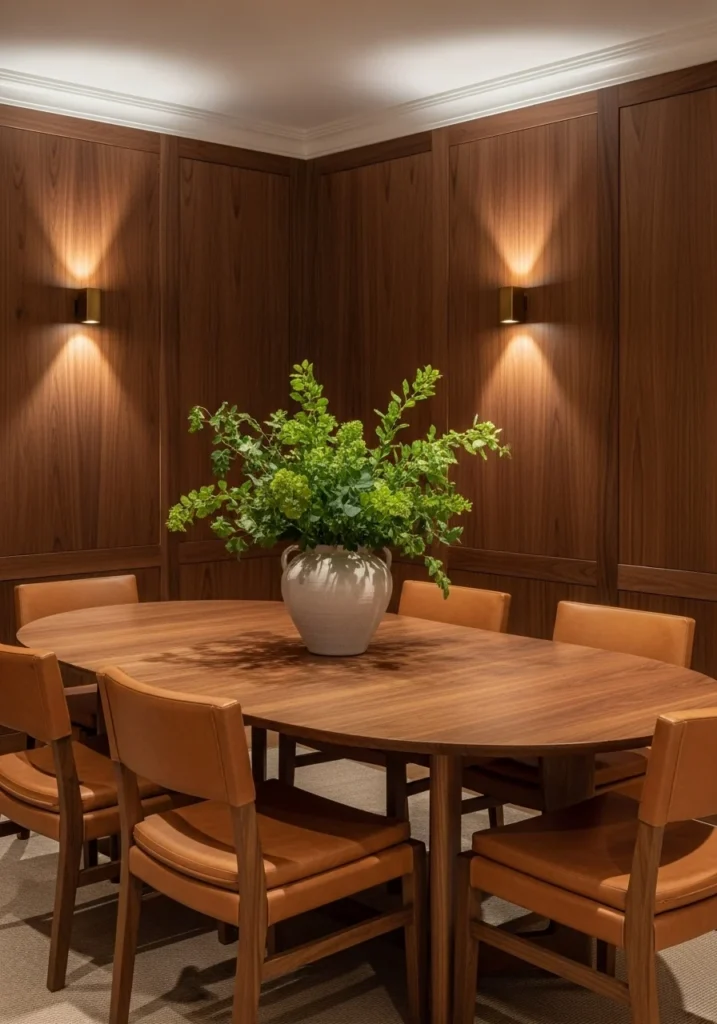
Rich walnut wall panels bring warmth and sophistication while an oval wood dining table with cushioned leather chairs in tan creates the seating area. Subtle brass sconces mounted on the panels add evening drama.
A simple, oversized ceramic vase filled with greenery centers the table for natural balance. The wall treatment should feel architectural and permanent, not like something you stuck up last weekend.
Layer Different Textures Thoughtfully
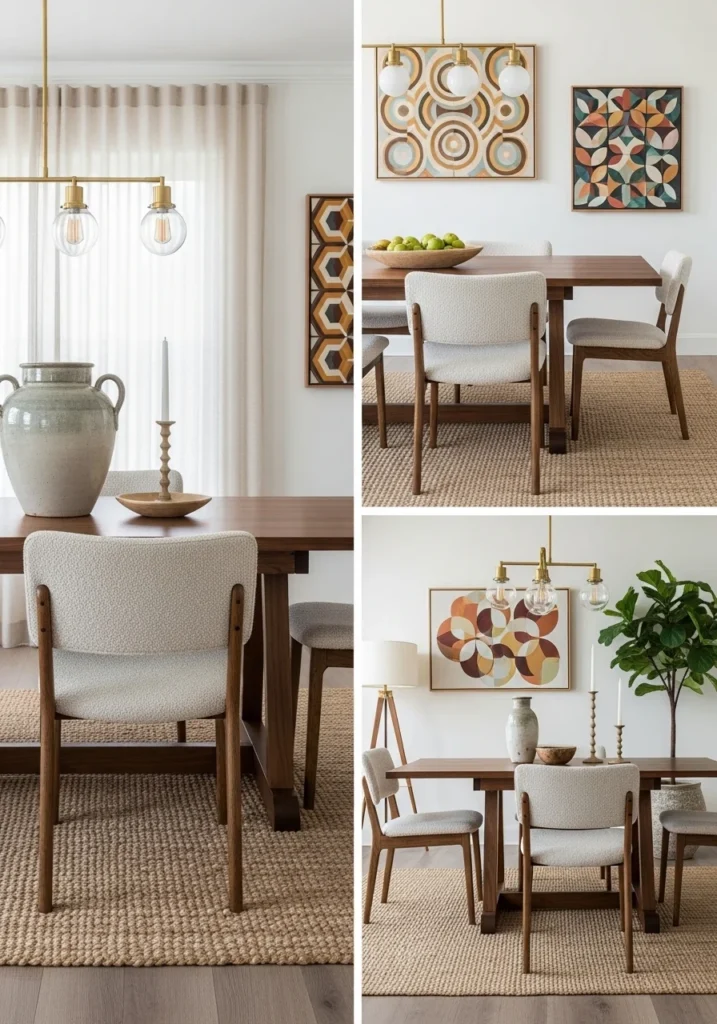
Blend textures strategically—boucle dining chairs, walnut table surfaces, brass lighting fixtures, and jute rugs create tactile interest. Sheer curtains allow natural light while geometric-patterned artwork adds retro character.
A large ceramic planter with fiddle-leaf fig ties in earthy softness that balances all the harder materials. Each texture should serve both aesthetic and functional purposes.
Invest in a Quality Credenza
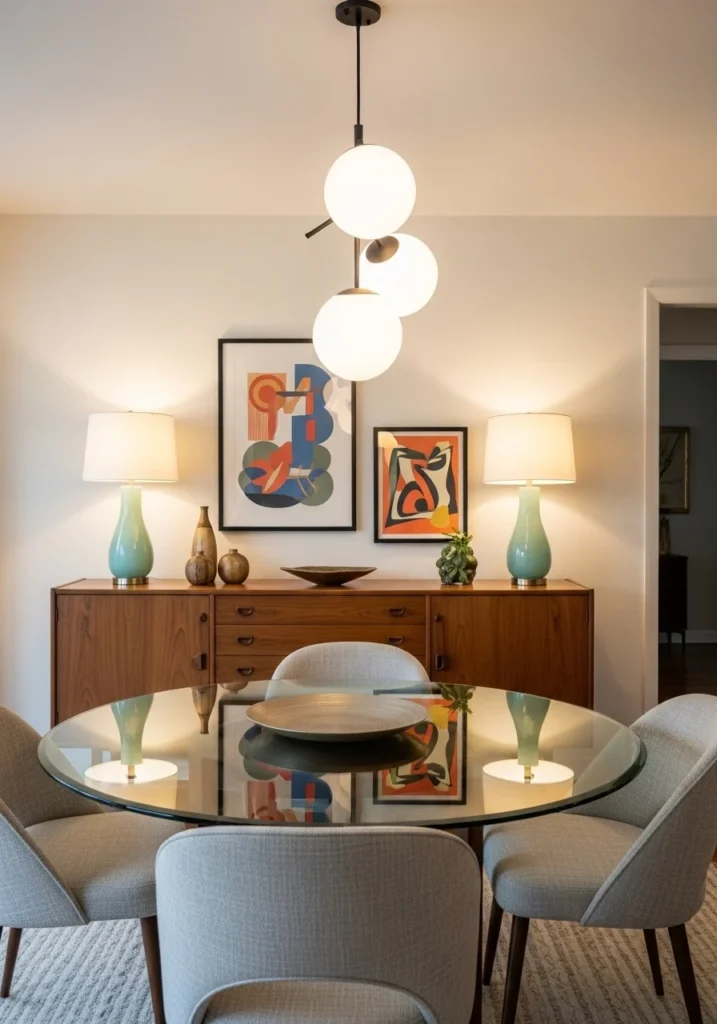
A mid-century walnut credenza topped with vintage lamps and retro artwork becomes both storage and display opportunity. Pair with a round glass-top dining table surrounded by upholstered bucket chairs for seating.
Three-globe pendant lighting adds soft illumination while the balance of functionality and design feels both elevated and timeless. The credenza should be substantial enough to anchor the room.
Finish With Thoughtful Details
Perfect Your Table Settings
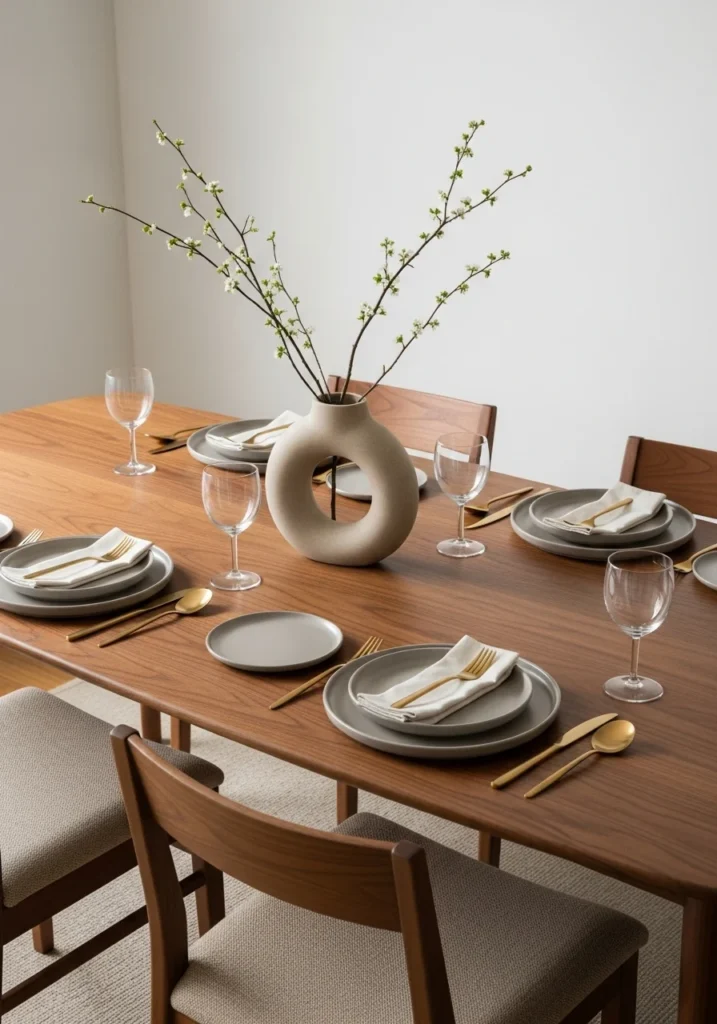
Style with minimalist place settings—stoneware plates in muted neutrals, brass cutlery, and hand-blown glassware create understated elegance. Use a walnut table with curved edges paired with simple wooden chairs upholstered in beige.
A single sculptural vase with branches anchors the centerpiece while keeping sightlines clear across the table. The settings should feel curated but not precious—people should want to actually eat there.
Bring in Living Elements
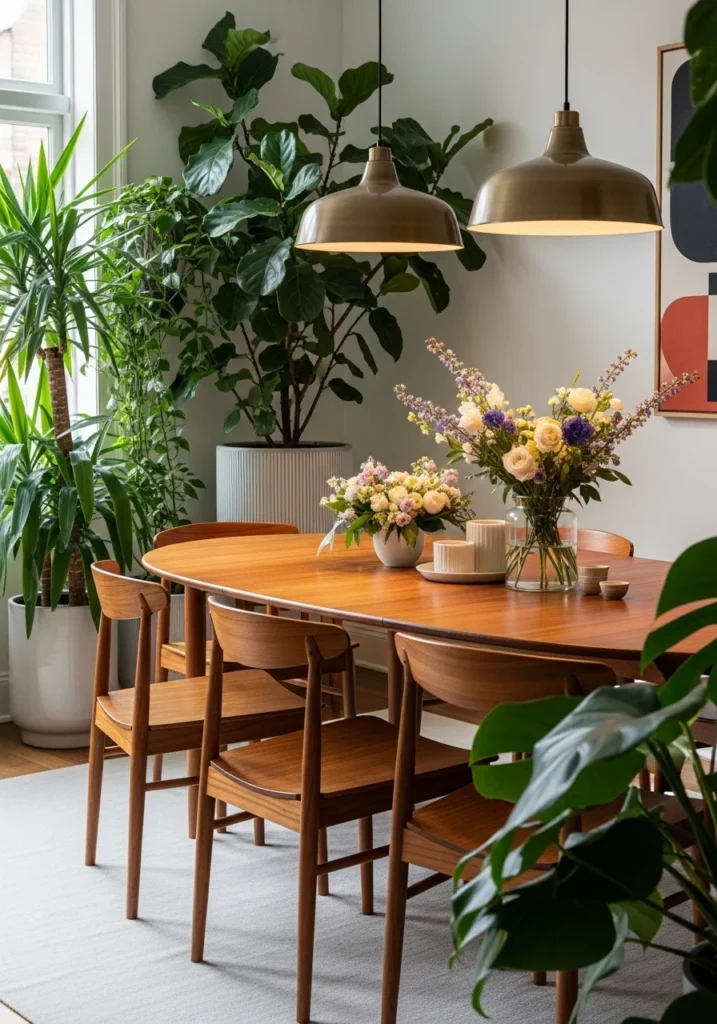
Complete the space with thoughtful greenery—large potted plants in ceramic planters and fresh florals on the table add life and softness. Position around a teak oval table surrounded by slim wooden chairs.
Matte brass pendant lighting casts warm glow while the mix of organic and geometric elements creates that perfect high-end, cozy vibe. Plants should feel abundant but not overwhelming.
Avoiding the Theme Park Look
The key to authentic mid-century style is restraint and quality over quantity. Don’t try to include every iconic piece from the era—choose a few statement elements and let them shine.
Mix Eras Thoughtfully – Combine genuine vintage pieces with contemporary mid-century inspired furniture. Everything doesn’t need to be from 1962 to look authentic.
Quality Materials Matter – Real wood, genuine leather, and quality brass will always look better than cheap imitations. Invest in fewer, better pieces rather than filling the space with knockoffs.
Function First – Every piece should serve a purpose. Mid-century design was about improving daily life, not just looking cool in photos.
Making It Work for Today
The best mid-century dining rooms adapt the style for contemporary living while honoring the original principles. Consider your actual lifestyle—do you entertain formally or casually? Do you need storage for everyday items or just display space?
Modern updates like improved lighting technology, contemporary upholstery fabrics, and current color palettes can keep the space feeling fresh while maintaining that authentic mid-century spirit.
Remember that mid-century design was about optimism, innovation, and quality craftsmanship. Your dining room should capture that same spirit while working perfectly for how you actually live and entertain today.
Final Thoughts
Creating an authentic mid-century dining room is about understanding the design philosophy behind the style, not just copying the visual elements. The best mid-century inspired spaces feel timeless because they prioritize good design principles over trendy details.
When your dining room successfully captures that mid-century magic, it will feel both nostalgic and completely current. People will want to linger over dinner, admiring the beautiful materials and thoughtful details while enjoying the comfortable, welcoming atmosphere you’ve created.
The goal is creating a space that honors the best of mid-century design while working perfectly for your modern life.

